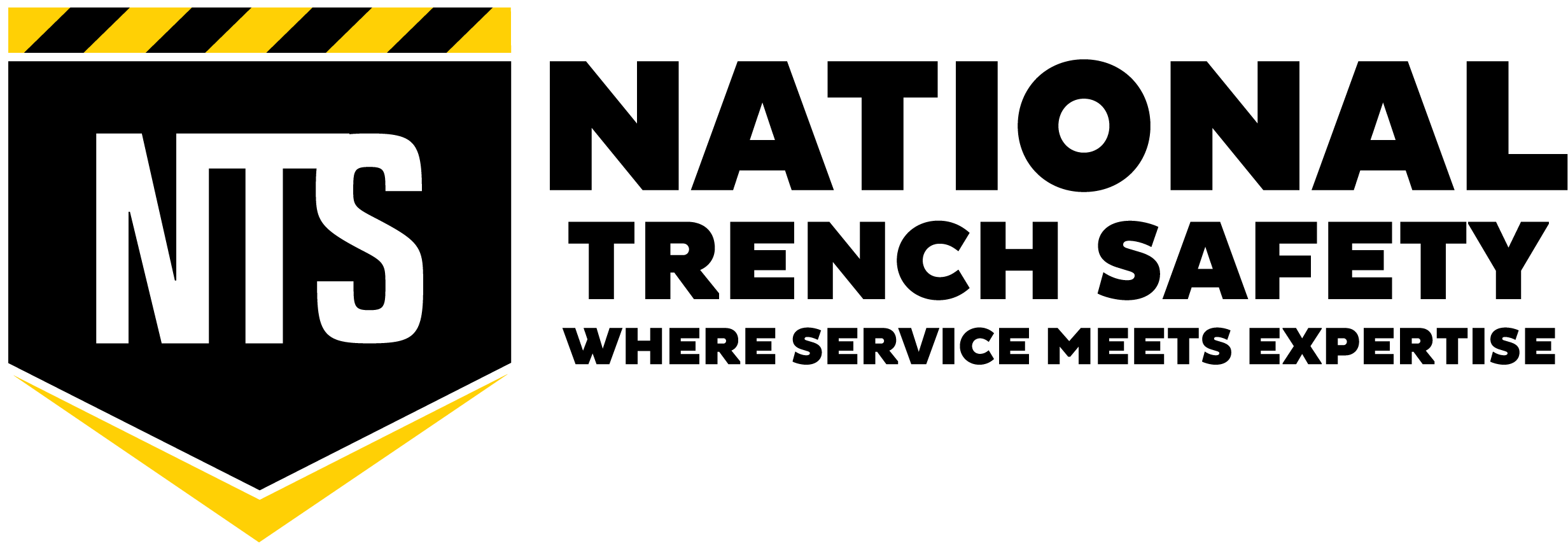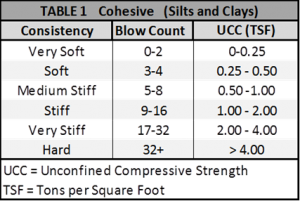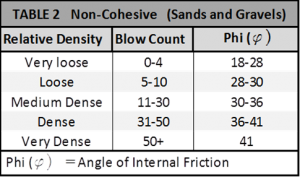On practically every construction project involving soil, whether excavating, moving, or building atop, there is usually a geotechnical investigation. The report is financed and commissioned by the owner and project design engineer for the purpose of obtaining soil properties relative to the structural stability and longevity of the project. The basic exploratory program most often consists of borehole drilling and sample recovery, testing of the borehole, visual and manual testing to classify the soil in accordance with the Uniform Soil Classification System, and further laboratory testing of samples taken from the drilling program. From the testing program and research regarding the geological setting, current history of the site, seismicity, hydrology, and chemical analysis from potentially contaminated sources a geotechnical report, including design recommendations, is developed.
The primary purpose of the soil report is to provide information on the design and longevity of the project being constructed. The report generally looks at a timeline of 100 years or more and encompasses permanent structures that will be in place over that time. One secondary purpose of the soil investigation is to gather constructability and shoring application design information. The excavation and shoring work period usually ranges from about 2 months to 1 year, with the system(s) installed, removed, and backfilled over that time period. The geotechnical engineer is typically most focused on the primary report featuring the design and longevity of the site. The extension to shoring, and even dewatering applications, is typically performed by the contractor, a shoring design engineer, and or a dewatering engineer as appropriate.
From the contractor’s perspective (excavation cost estimating, planning, and shoring design), there is certain key information within the report upon which the contractor focuses. This article provides a general framework on how a contractor may read a soil report to extract this information.
Our analysis will begin with the bore log (Figure 1). 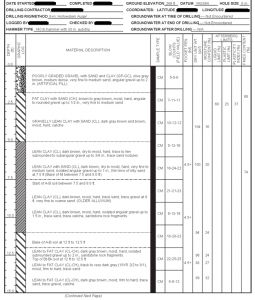 The boring log provides us with several key pieces of information including:
The boring log provides us with several key pieces of information including:
- The type of soil-cohesive (clays) or non-cohesive (sands and gravels)
- Water table
- Consistency of the soil;
- Cohesive properties-soft or -hard
- Non-Cohesive properties-loose or dense
- Permeable (how easily it gives up water)
From these three pieces of information, it’s usually possible to form a strong idea of how the site must be excavated and whether the soil will stand long enough for the shoring system to be inserted after a cut or if the site requires it to be shored first and then excavated.
From my own personal experience, I find the most direct way to determine soil type is to read the material description. For cohesive soils the terms soft to hard, as shown in the first column of Table 1-Cohesive Soils are always contained in the description of each layer and for non-cohesive soils, the terms very loose to very dense as shown in Table 2-Non-Cohesive Soils are always contained in the description of each layer. These terms are always used with their respective soil types and never interchanged, although notes about clay or sand may be included. Another way to determine the soil type is to look at the classification in the description, most often in parenthesis like (GP-GC) or (CL); however, the user would then have to look at the uniform classification table to determine whether it is in the cohesive or non-cohesive division. Determining soil type is fundamentally important because clays behave much differently than sands and gravels and affect virtually every shoring decision. One decision strictly based on soil type is that for cohesive soils dewatering can generally be achieved from sumps inside the excavation and for non-cohesive soils dewatering may require dewatering from wells outside the excavation. There is a significant cost difference between these two dewatering scenarios. Further examination of the soil classification can parse this out much closer but is not discussed in this article.
The water table level is also fundamental information. The extent of dewatering required  has a significant impact on the cost of dewatering and shoring. In the bore log the level is usually indicated by a small triangle or an upside-down Greek delta (D). It is also usually called out in the heading as groundwater at the time of drilling and ground water at some later date. If there is no reference to water in the bore log the general assumption would be that there is none.
has a significant impact on the cost of dewatering and shoring. In the bore log the level is usually indicated by a small triangle or an upside-down Greek delta (D). It is also usually called out in the heading as groundwater at the time of drilling and ground water at some later date. If there is no reference to water in the bore log the general assumption would be that there is none.
Consistency of the soil is easily determined by a “blow count” reading, which provides a measure of the soil density as generally measured by a standard penetrometer test (SPT). The blow count is taken at the time of drilling An SPT sampler is a hollow tube set on the end of the drill string. There is a trip hammer at the rig that drives it down. The test is performed by marking the drill string at the rig and counting the blows it takes to advance down every 6 inches. When the tube is pulled out the sample inside it can be retrieved and analyzed. Blow count readings simply provide a scale of how hard the soil is to penetrate. The penetration rate is different for cohesive and non-cohesive soils Cohesive soil blow counts generally run on a scale of 0 to 32 or more, while non-cohesive soil blow counts generally run on a scale of 0 to 50 or more (Tables 1 and 2 below provide an illustration).
The blow count unit of measure is represented as a 140 lb hammer drop over a 30-in fall. Looking at the bore log shown in Figure 1, the Blow Counts (Field Value) is shown in the fifth column from the left.. This is a strict reading of the number of drops. The 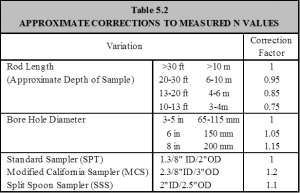 readings, such as (5-5-6) are how many drops it takes for each successive 6” depth increment. The first 6” is ignored and the blows per foot are 11. If the column heading does not state SPT it is because they are using different samplers from the SPT sampler. The Figure 1 boring sample was taken with a California Modified Sampler and not an SPT sampler. Table 5.2 shows different variations that the contractor should be aware of. At the bid stage and first reading, I do not suggest going through these corrections; however, at the shoring design stage, it should be checked out closer. The objective here is to get a quick contractor read of the bore log to glean the necessary information for bidding and shoring application decisions.
readings, such as (5-5-6) are how many drops it takes for each successive 6” depth increment. The first 6” is ignored and the blows per foot are 11. If the column heading does not state SPT it is because they are using different samplers from the SPT sampler. The Figure 1 boring sample was taken with a California Modified Sampler and not an SPT sampler. Table 5.2 shows different variations that the contractor should be aware of. At the bid stage and first reading, I do not suggest going through these corrections; however, at the shoring design stage, it should be checked out closer. The objective here is to get a quick contractor read of the bore log to glean the necessary information for bidding and shoring application decisions.
The blow count is the single most important piece of information needed to determine the strength of the soil. For cohesive soils (Table 1):
- A blow count range of 1 to 4 (soft) means OSHA Type C soil which would imply:
 shore before you dig applications, possible bottom heave, 6-in to 8-in wall shoring shields instead of a 4-in wall, using a slide-rail system or sheet pile over shoring shields, sloping at 1.5:1, and costly shoring systems over 8 ft deep.
shore before you dig applications, possible bottom heave, 6-in to 8-in wall shoring shields instead of a 4-in wall, using a slide-rail system or sheet pile over shoring shields, sloping at 1.5:1, and costly shoring systems over 8 ft deep. - A blow count range of 5 to 16 (stiff) means OSHA Type B soil which would imply: the soil can stand depending on excavation speed long enough to dig and insert the shoring, shoring shields at depths to approximately 16 ft, sloping at 1:1, and thinner wall shoring shields and most aluminum shoring equipment will work.
- A blow count range of 17 to 32 (very stiff) means OSHA Type A soil, which would imply: stands up at greater depths, is hard to dig, hard to drill and drive sheet piles through, sloping at ¾:1, and is harder to push slide-rail systems through.
- Note: for the above example wall thickness discussion makes the assumption of deeper excavations with wider clear spans typical of excavation construction. These are for illustrative purposes only and referencing tabulated data will provide the necessary context for these discussions.
For non-cohesive soils (Table 2):
- A blow count range of 0 to 10 (very loose to loose) means OSHA Type C soil
 which would imply: shore before you dig, possible boiling if the water table is present, 6-in to 8-in wall shoring shields instead of a 4-in wall, using a slide-rail system or sheet pile over shoring shields, sloping at 1.5:1, and costly shoring systems over 8-ft deep.
which would imply: shore before you dig, possible boiling if the water table is present, 6-in to 8-in wall shoring shields instead of a 4-in wall, using a slide-rail system or sheet pile over shoring shields, sloping at 1.5:1, and costly shoring systems over 8-ft deep. - A blow count range of 11 to 30 (medium dense) means OSHA Type B soil which would imply: if the particles are subangular (broken versus rounded), the soil can stand depending on excavation speed long enough to dig and insert the shoring, shoring shields at depths to approximately 8-ft, further analysis of fines and cohesive content can help determine stand-up-ability, sloping at 1:1, and thinner wall shoring shields and most aluminum shoring equipment will work.
- A blow count range of 31 to 50 (dense to very dense) which would imply that the soil: stands at greater depths, over 45 blows hard to drive sheet piles in, possibly sloping at ¾:1, and lighter shoring loads translating into less costly shoring systems.
- Note: for the above example wall thickness discussion makes the assumption of deeper excavations with wider clear spans typical of excavation construction. These are for illustrative purposes only and referencing tabulated data will provide the necessary context for these discussions.
When assessing the costliness of a project, (1) shore first and dig later, (2) soil’s ability to stand, and (3) dewatering requirements are three of the most critical factors a contractor should review. These factors should be analyzed very closely at bid time. If the contractor is unsure or unable to obtain a definitive answer from the bore log, it may be pragmatic to consult an engineer regarding the soils and potential ramifications for the project.
The recommendations regarding shoring and dewatering are another important piece of the soil report that the contractor should review. Similar to the manner, which a general practitioner doctor will not typically override a heart specialist’s recommendation to his patient, a project design engineer will not usually override a geotechnical engineer’s recommendation. All shoring and dewatering recommendations and loading diagrams should be considered when pricing the bid for the project. These recommendations tend to be conservative, restrictive, and costly, however, improperly addressing the risk could lead to a significant unplanned cost if the project owner or engineer requires a more robust system to address the recommendations.
At the time of bid, the geotechnical report is generally the best source of information regarding soils a contractor has at its disposal. There are generally a couple of clauses in the contract specifications that try to ignore or negate this fact. These clauses are legally termed exculpatory since they try to exonerate the owner’s responsibility to provide factual information to the contractor that he could not otherwise obtain prior to bid. Here are three typical methods a contract may seek to do this:
- A simple statement saying the contractor is not to rely on the project geotechnical report
- The contractor has a right to formulate his bid based on all information generated for the design.
- The contractor needs geotechnical information to formulate his bid. At bid time there is not sufficient time or money available to do a geotechnical investigation.
- Offer to allow the contractor to dig test holes at the time of bid
- Test holes or backhoe digs are expensive, require permitting, and can only supplement the information included in the project report
- Require the contractor to obtain his or her own separate geotechnical investigation and obtain shoring design recommendations from that geotechnical engineer.
- This is common in some states, especially California; however, it can set up potential conflicts and is very costly. If the independent investigation divulges conflicting information or simply unknown information automatically the project geotechnical investigation is called into question. If the geotechnical shoring design recommendations are different from the project recommendations the project design engineer is still locked into the original investigation requirements. This usually leads to requiring the second geotechnical engineer to review and accept, the original report and shoring design recommendations. This just leads to reliance on the original report with an additional cost to the project that comes with passing responsibility off to someone else.
From the contractor’s perspective, the bottom line this should be a key negotiating point for the contractor with the contractor fighting for the responsibility to stay with the owner and the owner’s engineer. Given a satisfactory negotiation to the responsibility, the contractor should formulate and bid shoring costs on the project geotechnical report and not add excess costs to cover every “what if” that may arise or fight the exculpatory clauses. The contractor is faced with the hard choice of pricing these issues properly and not getting the bid or taking a risk by costing with what he thinks he can get away with.
At National Trench Safety we believe that awareness and education on these issues help get all costs associated with shoring applications into the bid. NTS’s Engineering Division routinely consults with clients during the estimating phase of a project as well as the post-bid phase on potential excavation system solutions to assist our customers with developing safe, practical, and cost-effective shoring solutions.
DISCLAIMER: the information contained in this article is provided for general and illustrative purposes only and is not to be considered Site Specific and or designated engineering for any project or work zone, nor is it to be used or considered to be tabulated data, technical data, advice and or counsel to be used on any job site. Each project is different and is the responsibility of the employer’s designated Competent Person to make decisions on what systems and methods may be used in compliance with federal and local regulations, manufacturers tabulated data, engineered drawings, and other plans.
